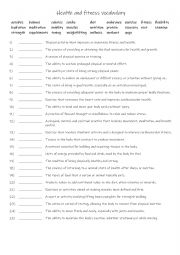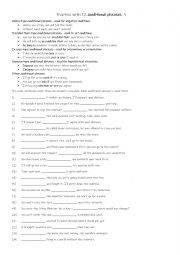
|
A2+-B1+ Health and fitness vocabulary
First, students need to familiarise themselves with the 25 words and their meanings Then they read the definitions to see which one is being described and write that word in the space provided. Answers on page 2.
Level: elementary
Age: 10-100
Type:
Downloads: 122
|

|
A1+ A2 Practise with past simple, past continuous & present perfect 3
First, students need to familiarise themselves with the 3 tenses and their use. Then they read the sentences to work out which one is needed to complete the gap-fill using the given verb in (). Each tense is used 9 times! Answers on page 2
Level: elementary
Age: 9-100
Type:
Downloads: 122
|

|
Going to for experience and knowledge of what is going to happen 1
First, students need to familiarise themselves with the verbs and their meanings. Then they read the sentences to see which one is required to complete the sentence. Answers on page 2.
Level: elementary
Age: 8-100
Type:
Downloads: 122
|

|
Practise with 12 conditional phrases 1
First, students need to familiarise themselves with the 12 conditional phrases and their meanings and use. Then they read the sentences to see which one is suitable to complete the gap-fill. Each conditional phrase is used 2 times! Answers on page 2.
Level: intermediate
Age: 10-100
Type:
Downloads: 122
|

|
A2+-B1 Practise with past simple, past continuous, present perfect, present perfect continuous, past perfect & used to 3
Practising these tenses helps students express different aspects of time and actions effectively. The past simple is vital for describing completed actions, while the past continuous sets scenes or shows interruptions in the past. The present perfect connects past actions to the present, and the present perfect continuous highlights ongoing or repe...
Level: elementary
Age: 10-100
Type:
Downloads: 122
|

|
B1+-C1 Choice idioms and expressions 2
This is a speaking reinforcement activity to supplement the other worksheet I uploaded on 13/2/2025. Students working in pairs or small groups can either ask each other the questions or answer the question themselves.
Level: intermediate
Age: 12-100
Type:
Downloads: 122
|

|
Practise with 9 questions words 3
Students familiarise themselves with the 9 question words and their use. Then they read the questions to see which question word is required to complete the questions. Answers on page 2.
Level: elementary
Age: 7-100
Type:
Downloads: 122
|

|
Quantifier practise using How much, How many, a, an, some & any 4
Students first familiarise themselves with the 6 quantifiers and their use. Then they complete the gap-fill with the correct word. Each quantifier is used 4 times! Answers on page 2.
Level: elementary
Age: 8-100
Type:
Downloads: 122
|

|
B2-C1 30 issues on the minds of a lot of today�s people 1 b
These questions reinforce the vocabulary in worksheet 1b and can be done in pairs, small groups or the whole class.Learning about social issues can inspire you to become an advocate for social justice and equality. It equips you with the knowledge and understanding needed to challenge prejudice, discrimination, and systemic inequalities in your own...
Level: advanced
Age: 15-100
Type:
Downloads: 121
|

|
A2-B1 Present perfect practise
Students read the sentences and complete it using the present prefect and the clue (+) or (-). There are 12 positive and 12 negative sentences. This worksheet is suitable for A2-B1 students as it contains complex sentences. Answers on page 2.
Level: elementary
Age: 10-100
Type:
Downloads: 121
|












